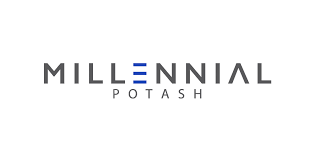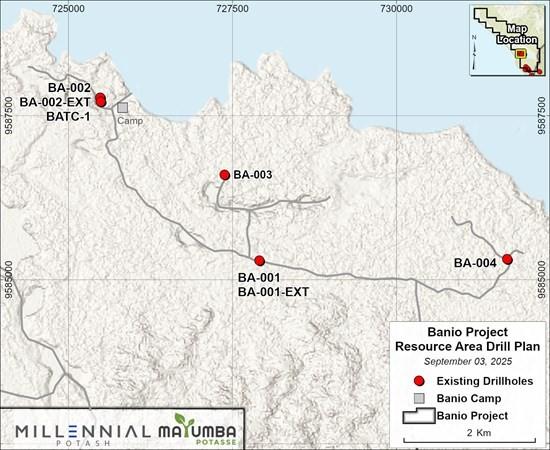
Millennial Potash Intersects 101.45m Cumulative Potash Thickness of High-Grade Carnallitite Mineralization in Drillhole BA-004 at its Banio Potash Project in Gabon

Millennial Potash Corp. (TSX-V: MLP) (OTCQB: MLPNF) (FSE: X0D) is delighted to announce that it has received analytical results for drillhole BA-004 at its Banio Potash Project in Gabon. Hole BA-004 intersected an impressive 101.45m cumulative metres of carnallitite seams averaging 16.8% KCl, using a 13% cut-off grade. The 101.45m of rich carnallitite seams are situated within evaporite Cycles II to Cycle VIII which are hosted by the Salt Sequence stratigraphy at the project. This cumulative potash thickness of 101.45m compares very favourably with the 112.5m cumulative thickness intersected in BA-001-EXT and significantly exceeds the +70m cumulative thicknesses encountered in drillholes BA-002-EXT and BA-003 completed in 2024.
Farhad Abasov, Millennial’s Chair, commented “Millennial is excited to announce the assay results for hole BA-004 containing over 101m cumulative potash thickness with an average grade of 16.8% KCl. Our drill program keeps generating significant results demonstrating consistency and continuity of potash cycles in this part of the project area. In addition to very thick potash horizons, it is also encouraging to see potash grades reaching 29% KCl over some cycles. This potash seams in this drillhole are significantly thicker than the approximately 70m thick cumulative zone delineated in holes BA-002-EXT and BA-003 as reported in 2024 and are in line with the impressive 112m zone intersected in BA-001-EXT. These consistent and remarkable results reinforce Millennial’s confidence in Banio’s potential to expand its current Mineral Resource Estimate and highlight the project’s exciting development trajectory. We intend to update our Mineral Resource Estimate soon as all the assay results have been received. I would like to congratulate our technical team on the successful completion of the Phase II drill program.”
Drillhole BA-004 is located approximately 3.7km east of drillhole BA-001-EXT in the centre of the North Target (see Fig. 1). BA-004 represents a step-out hole designed to test the eastward extension of the extensive potash mineralization intersected in BA-001-EXT, BA-002 and BA-003. The re-processing of historic seismic data completed by the Company in 2023 (see news release dated April 26, 2023) indicates the evaporite basin is basically flat lying and continuous to the east. BA-004 was drilled vertically to a depth of of 667m and intersected the evaporite-bearing Salt Sequence from approximately 260m to the bottom of the hole at 667m confirming this interpretation of the basin.

Figure 1 Drillhole location map, Banio Potash project
One hundred and fifty-two core samples, from BA-004, ranging from 13cm to 187cm in length, were submitted to the Saskatchewan Research Council laboratories for potash analysis. Interpretation of the geology and distribution of mineralization by the Millennial team and our potash consultants, ERCOSPLAN Ingenieurgesellschaft Geotechnik und Bergbau mbH (“ERCOSPLAN”), defines seven Evaporite Cycles (Cycle II to Cycle VIII) in BA-004 which correlate and confirm the continuity of these same Cycles which were intersected in all previous drillholes. The Cumulative Total of potash mineralization, primarily interbedded carnallitite and halite, totals 164.76m averaging 11.86 % KCl with no grade cut-off applied (see Table 1). Thirty-one whole PQ-size core samples, typically 25-35 cm thick, were taken from the various seams encountered in BA-004 for dissolution and geotech testwork. Analytical results for these samples are pending the completion of the testwork however, given the mineralogical similarity of these samples with the remainder of the seam and the continuity that is characteristic of this and similar deposits, the average grade of the seam was assumed to be consistent and was assigned to those sample intervals by ERCOSPLAN. Should this assumption be incorrect, the grade currently assigned could vary. Upon completion of the testwork analytical results from these sample will be incorporated into the Banio Project database.
| Evaporite Cycle | Carnallite/Sylvinite Seams | From (m) | To (m) | Thickness (m)* | KCl (%) | ||||||||||
| Cycle VIII | Sy/C4 | 264.25 | 266.38 | 2.13 | 21.56 | ||||||||||
| Cycle VIII | C1 to C/Sy3 | 300.72 | 321.96 | 21.24 | 9.23 | ||||||||||
| Cycle VII | C1 to C6 | 455.00 | 531.09 | 76.09 | 8.96 | ||||||||||
| Cycle VI | C1 to C2 | 553.72 | 584.75 | 31.03 | 14.46 | ||||||||||
| Cycle V | C1 to C4 | 593.57 | 612.36 | 18.79 | 11.43 | ||||||||||
| Cycle IV | C1 | 626.66 | 630.32 | 3.66 | 15.35 | ||||||||||
| Cycle III | C1 | 636.18 | 641.10 | 4.92 | 20.91 | ||||||||||
| Cycle II | Sy/C1 | 652.83 | 659.73 | 6.90 | 29.94 | ||||||||||
| Cumulative | Total | 164.46 | 11.86 |
Table 1 Potash Cycles with Carnallitite Seams intersected with no cut-off grade applied
*Drilled thickness; true thickness interpreted=drilled thickness
Application of a 13% KCl cut-off grade to the seam intersection data yielded a Cumulative Total seam thickness of approximately 101.45m and an average grade of 16.8% KCl (see Table 2). This cumulative total exceeded the Company’s expectations as similar Cycles and seams in BA-002-EXT and BA-003 totalled approximately 70m and the average grade of 16.8% KCl is slightly higher than the current Mineral Resource Estimate (“MRE”) completed in 2024 (see MLP Jan. 16, 2024, Press Release).
| Evaporite Cycle | Carnallite/Sylvinite Seams | From (m) | To (m) | Thickness (m) |
KCl (%) |
| Cycle VIII | Sy/C4 | 264.25 | 266.38 | 2.13 | 21.56 |
| C/Sy3 | 300.72 | 304.00 | 3.28 | 16.63 | |
| C2 | 309.13 | 313.85 | 4.72 | 14.21 | |
| C1 | 316.43 | 321.96 | 5.53 | 14.06 | |
| Cumulative Total-Cycle VII | 15.66 | 17.20 | |||
| Cycle VII | C6 | 455.00 | 460.60 | 5.60 | 14.71 |
| C5 | 450.74 | 481.85 | 1.11 | <13% | |
| C4 | 491.37 | 492.44 | 1.07 | 14.23 | |
| C3 | 494.47 | 496.54 | 2.07 | 14.44 | |
| C2 | 511.10 | 516.52 | 5.42 | 14.82 | |
| C1 | 519.90 | 531.09 | 11.19 | 18.65 | |
| Cumulative Total-Cycle VII | 25.35 | 16.43 | |||
| Cycle VI | C2 | 553.72 | 566.87 | 13.15 | 14.34 |
| C1 | 568.28 | 584.75 | 16.47 | 15.79 | |
| Cumulative Total-Cycle VI | 29.62 | 15.15 | |||
| Cycle V | C3 | 593.57 | 603.46 | 9.89 | 13.20 |
| C2 | 605.16 | 606.05 | 0.89 | 19.70 | |
| C1 | 607.80 | 612.36 | 4.56 | 14.62 | |
| Cumulative Total-Cycle V | 15.34 | 14.03 | |||
| Cycle IV | C1 | 626.66 | 630.32 | 3.66 | 15.35 |
| Cumulative Total-Cycle IV | 626.66 | 630.32 | 3.66 | 15.34 | |
| Cycle III | C1 | 636.18 | 641.10 | 4.92 | 20.91 |
| Cumulative Total-Cycle III | 636.18 | 641.10 | 4.92 | 20.91 | |
| Cycle II | Sy/C1 | 652.83 | 659.73 | 6.90 | 29.94 |
| Cumulative Total-Cycle II | 652.83 | 659.73 | 6.90 | 29.94 | |
| Cumulative Total | 13% cut-off | 101.45 | 16.8 | ||
Table 2 Potash Cycles with Carnallite Seams intersected with 13% KCl cut-off grade
*Drilled thickness; true thickness interpreted=drilled thickness
The significant thicknesses of Cycles VII, VI, and V, 76.09m, 31.03mm and 18.79m respectively, are consistent with the same Cycles encountered in drillholes BA-002, BA-003 and BA-001-EXT. This continuity suggests potential for even further expansion of the potash mineralization to the south and east of the current drilling and beyond the 2024 MRE. In addition, sylvinite was identified at the top of Cycle VIII in BA-004 and at the bottom of the potash cycles in Cycle II. The occurrence of sylvinite in Cycle VIII is similar to results from BA-002 and 003 however the presence of sylvinite in Cycle II is uncommon and could add some higher-grade potash to the project.
The objective of drilling BA-004, and the overall Phase 2 program, was to evaluate the presence of potash-rich horizons laterally and at depth to provide additional data for a future MRE, and to collect samples for dissolution and geotechnical testwork. Identification of the 7 potash Cycles and their thick carnallitite seams outlined in BA-004 has extended the strike length of known potash mineralization to approximately 8km which could potentially add significant tonnage to the current Mineral Resource Estimate calculated for the project which currently comprises an Indicated MRE of 657M tonnes grading 15.9% KCl and an Inferred MRE of 1.159B tonnes grading 16% KCl (see MLP Jan. 16, 2024, Press Release). In tandem with any potential Mineral Resource Estimate increase, data from the Phase 2 drill program will provide data for the Company’s geological model for the basin and may allow upgrading of some resources from Indicated to Measured status and may possibly shift Inferred tonnage to Indicated status. As reported above, 31 representative samples from BA-004 have been selected for dissolution test-work and geotechnical creep test-work which will be incorporated in any future Feasibility Study.
QA/QC
Millennial employees follow standard operating and quality assurance procedures intended to ensure that all sampling techniques and sample results meet international reporting standards. Procedures for handling core samples begin with securing the potash-bearing PQ-HQ-sized core at the drill site in plastic poly-tubing which is then thermally sealed. Core is placed in rigid core boxes and transported to Millennial’s camp for geological logging, detailed geotechnical logging, and photographing. Significant intervals are dry cut in half for HQ core or quartered for PQ core using a specially modified tungsten carbide bladed core saw. Half (HQ size) and quarter core (PQ size) samples are then double bagged and thermally sealed prior to transporting to Libreville by Millennial personnel. The remaining core is re-sealed in plastic poly-tubing and the core boxes secured at Millennial’s exploration camp in air-conditioned containers to prevent deterioration of the potash minerals. Upon arrival in Libreville core samples are stored at Millennial’s storage facility and then taken to the Gabon Ministry of Mines & Energy where permission is obtained to export the samples. The bagged samples are then carefully packed into wooden crates and shipped via DHL to the Saskatchewan Research Council (SRC) laboratory in Saskatoon. This sampling procedure was initiated by ERCOSPLAN Ingenieurgesellschaft Geotechnik und Bergbau mbH, Millennial’s potash consulting firm, supervised by Millennial’s Chief Executive Officer Jason Wilkinson, M.Sc., Sebastiaan van der Klauw, EurGeol from ERCOSPLAN, and periodically reviewed by Millennial Director, Peter J. MacLean, Ph.D., P. Geo.
Millennial is utilizing SRC’s Potash ICP Analysis package designed for multi-element analysis of potash samples. Upon arrival at SRC Geoanalytical Laboratories, core samples are dried, and jaw crushed to 95% @ -2mm and 100 g sub sample is split out using a riffler and transferred to vials. The subsample is pulverized to 95 % @ -106 microns using a puck and ring grinding mill to create a pulp. The grinding mills are cleaned between groups using Quintus quartz. The pulp is then transferred to a labelled plastic snap top vial. An aliquot of pulp is placed in a test-tube with 15 ml of 30°C DI water. The sample is shaken. The soluble solution is then analyzed by ICP-OES. The method is suitable for the soluble analysis of commercial potash (Sylvite and Carnallite). The samples are analysed for FeO (wt%), K2O, Na2O, MgO, and CaO and a suite of trace elements. Br and Cl are determined using ICP-Ms and a gravimetric determination of the insoluble content for each sample is made. SRC’s internal protocol includes the insertion of internal standards and repeats, and review of this data shows no significant deviation from the accepted values. SRC Geoanalytical Laboratories has been certified by the Standards Council of Canada (SCC) to conform to the requirements of ISO/IEC 17025:2005 (CAN-P-4E).
The information in this news release has been reviewed and approved by Sebastiaan van der Klauw, EurGeo of ERCOSPLAN and Peter J. MacLean, Ph.D., P. Geo, Director of the Company, both of whom are Qualified Persons as that term is defined in National Instrument 43-101.
MORE or "UNCATEGORIZED"
Doubleview Extends High-Grade Domains at Hat: H099 Returns 438m of 0.40% CuEq Including 52m of 1.02% CuEq, Expanding Mineralization Envelope Around Conceptual Pit Vertically and Laterally
Doubleview Gold Corp. (TSX-V: DBG) (OTCQB: DBLVF) (FSE: 1D4) is pleased to announce assay results f... READ MORE
Cosa Closes Upsized C$7.5 Million Private Placement
Cosa Resources Corp. (TSX-V: COSA) (OTCQB: COSAF) (FSE: SSKU) is pleased to announce that it ... READ MORE
Americas Gold and Silver Closes US$132.25 Million Bought Deal Financing
Americas Gold and Silver Corporation (TSX: USA) (NYSE American: USAS) is pleased to report that it h... READ MORE
1911 Gold Closes C$23 Million "Best Efforts" Life Offering & Private Placement and Provides Corporate Updates
1911 Gold Corporation (TSX-V: AUMB) (FRA: 2KY) is pleased to announce that it has completed its prev... READ MORE
Endeavour Silver Completes US$350 Million Offering of Convertible Senior Notes
Endeavour Silver Corp. (NYSE: EXK) (TSX: EDR) announced today the closing of its previously announce... READ MORE












